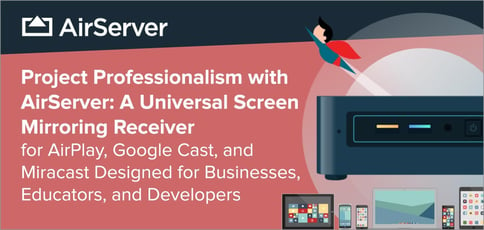
TL;DR: AirServer is an AirPlay, Miracast, and Google Cast receiver for Mac, PC, Xbox One, and Microsoft Surface Hub. The innovative technology, which has multiple use cases in education, business, development, and gaming, allows customers to display content from a range of devices on a common screen. With plans for even more streamlined connectivity in the works, AirServer aims to lead the way in mirroring receiver tech.
When Steve Jobs announced the release of the second-generation Apple TV during a live event September 1, 2010, he also introduced AirPlay. The revolutionary proprietary technology allowed Apple users to wirelessly stream content — including videos, music, and photos — between compatible devices for the first time.
But, much to the dismay of those who had already adopted the technology, AirPlay was not compatible with the first-generation Apple TV. So while Apple left its first-generation users in the dust, Pratik Kumar, CEO of App Dynamic, began to search for a way to include them.
By January 2011, he had succeeded, releasing the world’s first app capable of bringing AirPlay to first-generation Apple TV users. “The fact that he was able to make it work attracted a lot of press attention, and that was the beginning of AirServer as a company under App Dynamic,” said Thorvaldur (Thor) Einarsson, VP Business Development at AirServer.

AirServer is an advanced screen mirroring receiver.
Then, in September 2011, AirServer took things a step further by introducing the world’s first AirPlay receiver for Mac with audio streaming. Since then, the company has continued to focus heavily on innovation.
Today, AirServer is one of the most advanced AirPlay, Google Cast, and Miracast receivers around. The technology, compatible with Mac, PC, Xbox One, and Microsoft Surface Hub, allows users to display multiple devices on a common screen without the need for restrictive cables. With a range of use cases in education, business, development, and gaming, plus plans for continual improvement, AirServer is continuing to make its mark on the history of mirroring technology.
Display Multiple Devices Simultaneously on a Common Screen
AirServer has remained compatible with AirPlay since iOS 4.2.1, offering free upgrades with every major iOS release since 2011. Still, as AirServer evolved, Thor said the technology shifted from being primarily an AirPlay solution to a replacement for HDMI in collaborative spaces such as meeting rooms and classrooms. “We’ve been leaders in that market from the beginning,” he said. “There’s a lot of competition, but quality-wise, I believe we are number one.”
The software allows users to receive AirPlay and Google Cast streams by turning a Mac or PC into a universal mirroring receiver. Install AirServer on a computer, and it will be transformed into a receiver. With AirServer enabled on a large desktop screen, users can wirelessly mirror their display to the big screen, instantly prepping the room for collaboration.

AirServer provides instructors with a bird’s-eye view of digital work.
Users can mirror their screen from any device that is compatible with AirPlay or Google Cast, including Mac, iPhone, iPad, Android, and Chromebook. The technology also supports Windows and Linux platforms through Google Cast’s integration with the Google Chrome browser.
AirServer for Mac also preserves Retina-quality mirroring. Users with an iPhone 6 Plus or later models can mirror at the full 1080 x 1920 resolution — a 300% improvement over the previous pixel count in portrait mode. In addition, AirServer’s high-quality recording feature allows users to capture their mirroring sessions in the form of professional videos.
The company’s Bring Your Own Device (BYOD) solution ensures a wide range of users with different devices can mirror their displays in a collaborative setting. “The software is designed to allow for multiple users at the same time,” Thor said. “We can have up to nine or 10 users screen mirroring at the same time, to the same screen, in high definition at 60 frames per second.”
Thor said compatibility is what AirServer’s all about. There’s no jailbreaking required; in fact, he said that, other than a simple desktop installation, users don’t have to install any apps — they can use what’s natively on their device.
Cut the Cord: Freely Move and Collaborate with Device in Hand
Anyone who’s spent hours talking on a landline phone knows the pain involved in being tethered to a device. Sure, stretching out the springy cord was fun, but that joy was quickly overshadowed by an infuriating lack of mobility.
Whether you’re on the phone, giving a business presentation, or teaching a classroom, it’s never fun to held back by cords, and that’s why AirServer enables screen mirroring without them. For AirServer, that means delivering a solution that will work 100% of the time.
“Wireless technology can’t be a replacement for cables if it only works 80% to 90% of the time, as most solutions on the market do,” Thor said. “With those success rates, people aren’t going to skip cables.”

With AirServer, presenters have the ability to move around the stage freely.
In addition to software, the company’s new AirServer Connect hardware offers the world’s first 4K Ultra-High Definition all-in-one mirroring device. The device, which can receive AirPlay, Google Cast, and Miracast all at the same time, comes with a wireless guest network. It’s also capable of receiving and displaying more than eight full-quality connections simultaneously, compared to a single connection for Apple TV 4K, Chromecast Ultra, and the Microsoft Wireless Display Adapter.
According to Thor, AirServer Connect is four times faster than AirServer on Windows. It can also display eight times more connections compared to an Apple TV 4K, Chromecast Ultra, and Microsoft Wireless Display Adapter — all while eliminating brand-specific device restrictions.
Thor said businesses and educational institutions are the target audience for AirServer Connect since the device is pricier than a Google Chromecast or Apple TV device but offers more features and support for multiple mirroring protocols. “We focus on usability so that general meetings and classes can get started on time with everyone being able to share their screens, no matter what device they use,” he said. “That’s the main benefit — plus, IT and AV managers get dependable devices that they can easily deploy and manage remotely.”
Multiple Use Cases: Education, Business, Development, Gaming
AirServer caters to a broad client base, including teachers, businesses of all sizes, developers, and gaming enthusiasts. On the software side, Thor said the company is quite successful with the Xbox platform. “AirServer is the only proper mirroring solution for Xbox, so we’ve got a lot of business there,” he said. “Gamers use it a lot for streaming, especially for mobile games.”
The company’s gaming features allow users to transform their computer and iOS device into a robust gaming console supporting 16 simultaneous device connections. Gamers can record games for replay, create game reviews, and offer in-game advice.

Game on: AirServer turns your multiplayer dreams into reality.
App Developers, on the other hand, can leverage the recording and mirroring tools to create user-friendly tutorials and demos. On the business side, AirServer gives users the freedom to execute presentations to the best of their ability. With AirServer installed on a laptop and an iPhone or iPad in hand, the presenter gains full control over the performance, including the ability to move around the stage, switch between media resources, and adjust the volume.
The benefits are similar in the educational realm, where teachers can use the technology to project a display on their device to a Mac or PC, where it is then routed to a projector, smartboard, or high-definition television.
“Many classrooms these days have a lot of students,” Thor said. “To make it easier for the teacher to see what everyone’s doing, each student could mirror his or her screen to a universal screen.”
In the Future: Streamlined Remote Management
Thor said market trends and user feedback will dictate the company’s development road map. “Our tech support team gathers a lot of feedback, and we also work closely with our customers in terms of testing new features,” he said.
To that end, the company is working on new features that will allow for enhanced remote connectivity and greater compatibility with touchscreens and interactive whiteboards. “The more you can make this process seamless, the easier it is for the IT and AV staff to manage the technology,” Thor said.
As AirServer continues to enjoy rapid growth, Thor said a combination of the right developers and the right company attitude are essential for lasting success.
“It’s important to be able to say, ‘no,’” he said. “We’ve received collaboration requests from the airline industry, auto industry, and fitness device industry, just to name a few. But in the long term, we want to be on every screen.”
HostingAdvice.com is a free online resource that offers valuable content and comparison services to users. To keep this resource 100% free, we receive compensation from many of the offers listed on the site. Along with key review factors, this compensation may impact how and where products appear across the site (including, for example, the order in which they appear). HostingAdvice.com does not include the entire universe of available offers. Editorial opinions expressed on the site are strictly our own and are not provided, endorsed, or approved by advertisers.
Our site is committed to publishing independent, accurate content guided by strict editorial guidelines. Before articles and reviews are published on our site, they undergo a thorough review process performed by a team of independent editors and subject-matter experts to ensure the content’s accuracy, timeliness, and impartiality. Our editorial team is separate and independent of our site’s advertisers, and the opinions they express on our site are their own. To read more about our team members and their editorial backgrounds, please visit our site’s About page.

